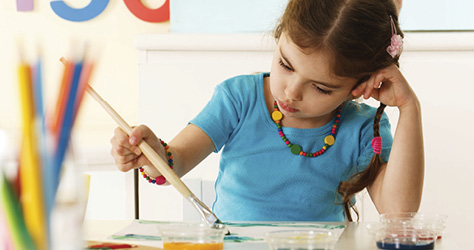Why can’t the sofa be a pirate ship and the floor the shark-infested sea?
Developing your little one’s imagination is really important. Here are some tips.
At a glance
- Feeding their imagination is fun
- Make up your own stories
- Encourage pretend play

Feeding their imagination isn’t just fun – it’s brilliant for their brain development
Kids who have rich imaginations have better communication skills, and research shows they turn into better problem solvers later in life. Using their imagination in pretend play also gives them a feeling of power and control, which life doesn’t often give a 2-year-old. It also allows them to practise what they’ve learned about the real world.
Here are some great ways to boost their imagination:
Read loads
It doesn’t have to be fantasy or fairy stories (though these are wonderful). Any picture book that introduces them to unfamiliar animals, people, vehicles – any new concept - will spark off their imagination in all new directions. Talk about the book at the end: what might happen to the character next? What’s their idea for a character?
Make up your own stories
This can be a particularly taxing bedtime request after a long day in the company of a toddler or pre-schooler. But if you can bear it they love it more than anything – and your story doesn’t even have to be very good. If you don’t know where to start, get them to suggest three things in the room to star in the story and take it from there. Let them take part by naming the characters as you go. When they get to three or four, take it in turns to do a line of the story. Not only will it boost their imaginary powers, it will also show them how to construct a story with a beginning, middle and end.
Encourage pretend play
From about 18 months to 2 years, toddlers begin imitating you and pretend-playing. Don’t let embarrassment stop you joining them on the boat (sofa) using a wooden spoon as an oar to row away from snapping crocodiles. You don’t need loads of bought props or dressing-up outfits – in fact simple ones are better as they are more versatile. Have a box of material scraps, old scarves, beads, shoes and hats for them to dig around in when they next get the urge to fight off crocodiles on your sitting room floor.
Don’t ask questions
If they’re deep in an imaginary game, don’t ask too many questions as it interrupts their flow and stops their imagination taking the lead. Make comments instead, as needed. (‘Wow, looks like that water’s deep!’)
The joy of den-making
On a rainy day, what could be better than turning a whole room into a hideaway with duvets, cushions, towels and chairs?
Dressing up
It’s fine to go to the supermarket in a princess outfit. (Them, not you.) Or if they want to go to pre-school in their knight costume, and there’s no uniform policy, that’s fine too.
Boys in girls’ clothes?
It’s not unusual for boys aged two or three to dress up in girls’ clothes or high heels round the house. It’s actually a sign of a good developing imagination and doesn’t mean they’ll be doing the same in 10 years.
Buy imagination-friendly toys
That means toys offering what psychologists call ‘open play’ so that the child decides how to use the toy. So wooden blocks, animal figures and household items like wooden spoons and saucepans are better for the imagination than electronic press-button play centres, which really only do the one thing they’re designed to do.